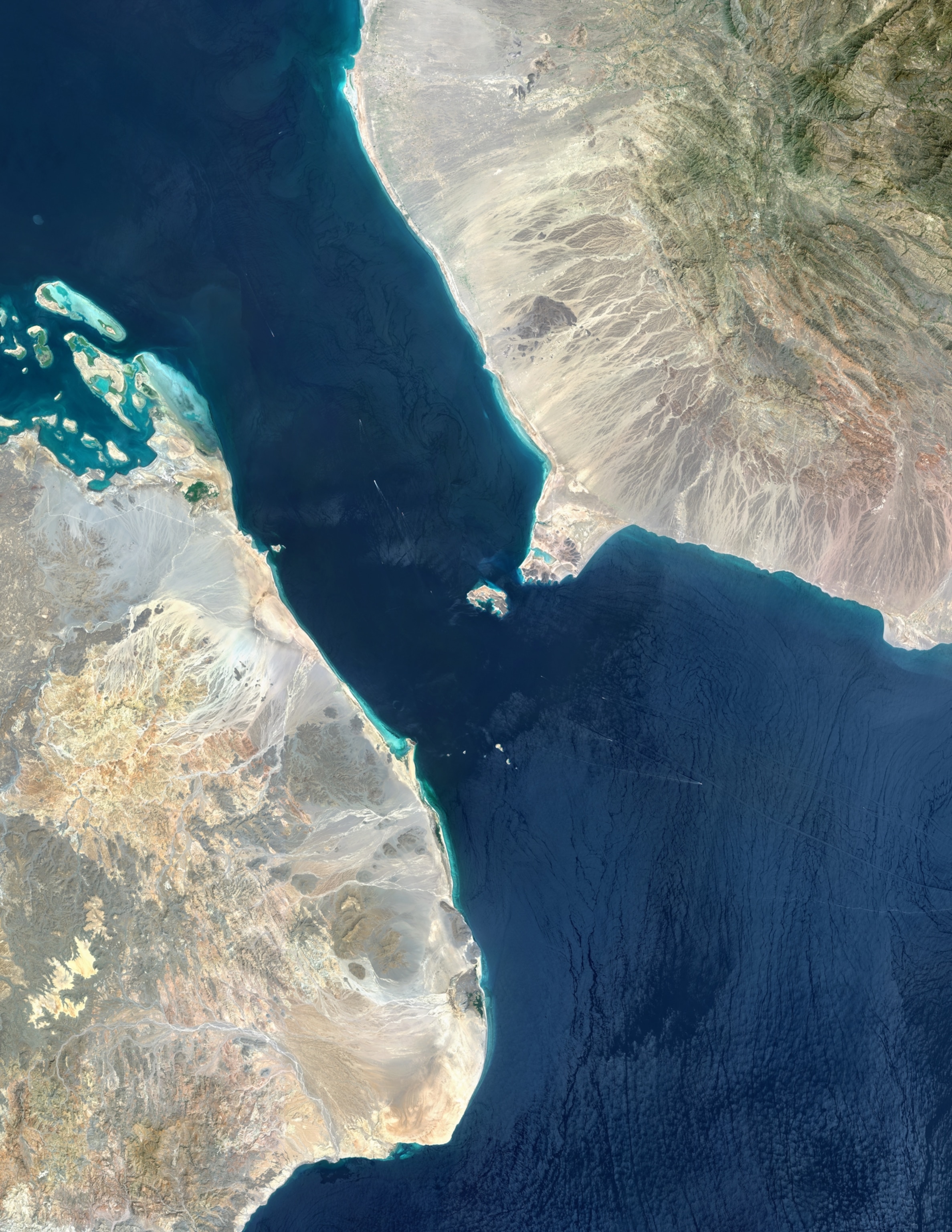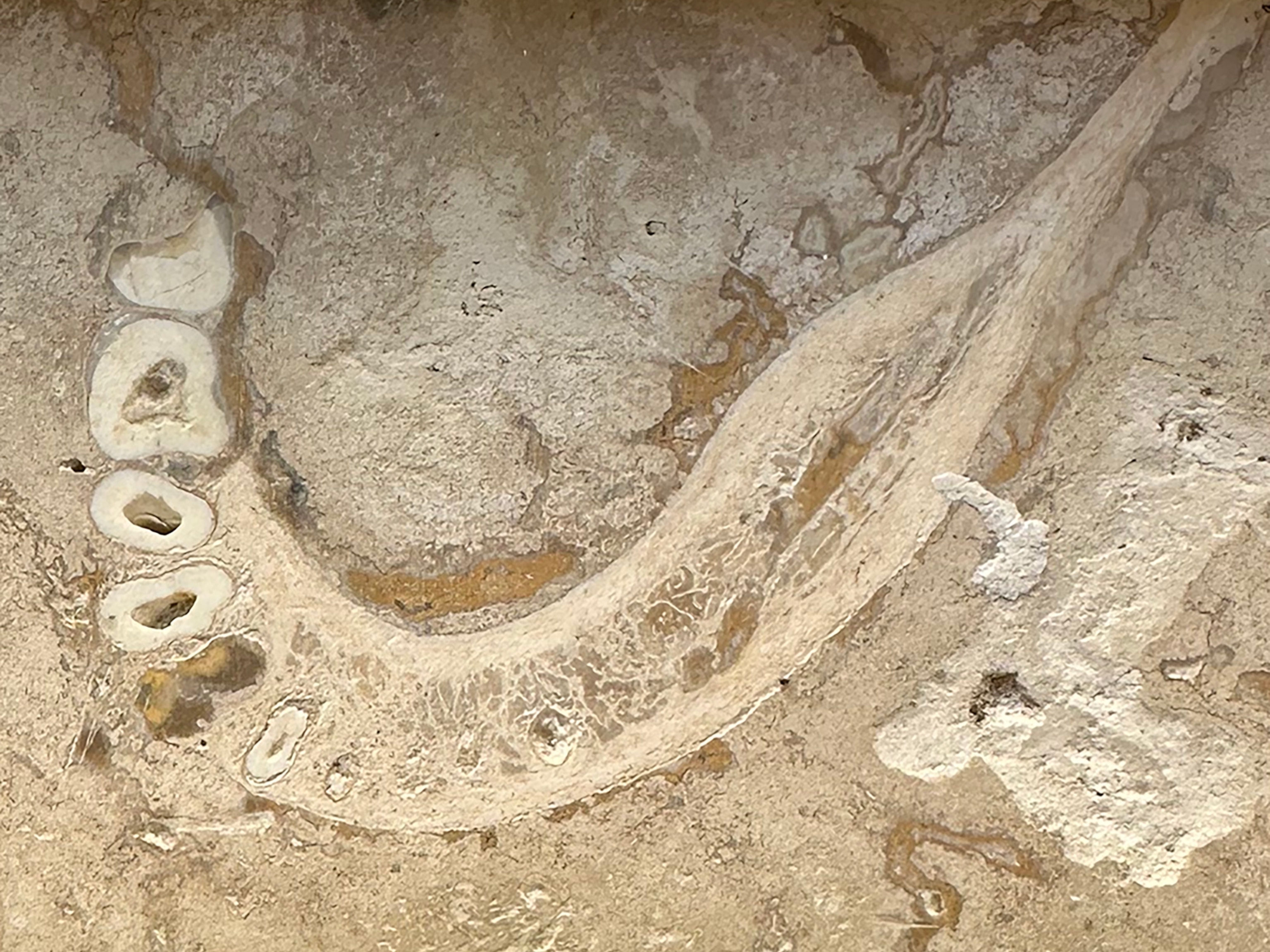This small strait is essential to global shipping. Now it's the center of headlines.
The location of the Bab el Mandeb on one of the world’s key shipping routes makes it a global flashpoint. Here's what you need to know about its history and its present.

The Bab el Mandeb is a small geographical chokepoint in the Red Sea with an outsized influence on world affairs: It’s the key to the control of almost all shipping between the Indian Ocean and the Mediterranean Sea via the Suez Canal. Recent drone attacks on commercial shipping in the Bab el Mandeb by Yemen-based Houthi forces have prompted a coalition led by the United States to launch military strikes against targets controlled by the militants. And while the Bab el Mandeb is currently making headlines, it’s also played an outsized role in human history—here’s what you should know.
What exactly is the Bab el Mandeb?
The Bab el Mandeb is a 20-mile-wide, 70-mile long strait between the Horn of Africa and the southern tip of the Arabian Peninsula that forms the southern entrance to the Red Sea from the Gulf of Aden, and the Indian Ocean beyond. The countries of Eritrea and Djibouti border it to the west, Yemen lies on its eastern edge.
An island called Perim (also known as Mayyun) dominates the narrowest part of the Bab el Mandeb on the Yemeni side, and the scattered Seven Brothers Islands extend from Djibouti a few miles farther south.
How and why did the Bab el Mandeb get its name?
The name Bab el Mandeb means “Gate of Tears” or “Gate of Grief” in Arabic, from “bab” meaning “gate” and “mandeb” (or “mandab”) meaning “lamentation.”
Its name appears to refer to the perils of navigating the narrow waterway, which is rife with crosscurrents, unpredictable winds, reefs, and shoals. Many ships in past centuries and millennia wrecked in the Bab el Mandeb, and modern ships also face the dangers of naval mines from bygone conflicts.
Why is the Bab el Mandeb in the news now?
A Yemeni rebel group known as the Houthis, who take that name from their founder Hussein al-Houthi, began an uprising in 2004 against Yemen’s official government, which they accused of siding against them with Saudi Arabia. Since 2014, the Houthis have controlled the capital of Sanaa and much of the west and south of the country.
The Houthis are mainly Shia Muslims with links to Iran, which has funded their rebellion against Yemen’s majority Sunni Muslim government and their attacks on Sunni-led Saudi Arabia. In late 2023, the Houthis announced they would target ships in the Bab el Mandeb in support of Iran-backed Hamas, currently fighting a war in Gaza with Israel.
Houthi forces have since fired missiles against several ships in the straits, as well as firing missiles at Israel.
How much shipping moves through the Bab el Mandeb between Europe and Asia?
The Bab el Mandeb, Red Sea, and Suez Canal are all vital links along the world’s key shipping route between Asia and Europe.
The International Maritime Organization estimates that up to a quarter of the world shipping passes along this route, which equates to several billion tons of cargo every year. That includes an estimated 4.5 million barrels of oil every day that originates in Persian Gulf and Asian countries, according to the U.S. Energy Information Administration.
What is the prehistoric importance of the Bab el Mandeb?
Most paleoanthropologists today favor an “Out of Africa” theory known as the “Recent African Origin” theory, which states that the modern human species Homo sapiens evolved in East Africa roughly 150,000 years ago.
From there, Homo sapiens migrated into the Middle East, Asia, Europe, and the Americas, replacing other hominin species that lived in many of those areas already.
If that’s the case, then the ancient migration from the Horn of Africa into the Arabian Peninsula was likely their first step—and some scientists proposed that the narrow Bab el Mandeb strait may have been a land bridge between the two regions for at least some of the time, caused by fluctuating sea levels.
A 2006 study, however, indicates no such land bridge across the Bab el Mandeb has existed for several million years, but a recent study proposed that the sea between the two regions was so narrow that it could easily have been crossed by drifting or swimming.
What’s been the importance of the Bab el Mandeb in modern times?
The Bab el Mandeb was renowned as a perilous sea crossing at the edge of the Mediterranean world for millennia; the riches of India and the Far East were known to lie beyond it, but the straits were a fearsome barrier and overland routes were often safer.
The “Gate of Grief” gained new global importance after 1869, however, with the opening of the Suez Canal in Egypt, which joined the Gulf of Suez in the northwest of the Red Sea to the Mediterranean Sea. The canal led to a dramatic increase in shipping in the Red Sea and through the Bab el Mandeb, and it soon became the preferred shipping route between Europe and Asia.
The British Empire had already seized the island of Perim in the Bab el Mandeb during the Napoleonic Wars, and decades later in 1856, fearing a resurgence of French power through the French-built canal under construction at the time, Britain fully occupied the island, stationing troops there and building a lighthouse; Britain used Perim mainly as a refueling station for coal-powered steam-ships travelling to and from its naval base at Aden, a port city on Yemen’s southern coast about 100 miles to the east of Bab el Mandeb.
The British presence in the area continued until the late 1960s, when Perim was handed over to the rulers of Yemen’s south. The south then became backed by the Communist bloc, while Egypt came to support the regime in Yemen’s north. The two sides fought a bitter civil war until their formal unification in 1990.
What has been the role of Bab el Mandeb since the 1960s?
The Bab el Mandeb has become a global flashpoint in recent decades because of the vast amounts of trade and oil that travel through it. Several world powers, including the United States and China, now maintain large military bases on the Djibouti side of the strait, supposedly to prevent the Bab el Mandeb from falling prey to hostilities.
The latest conflict in Israel is not the first to involve the Bab el Mandeb. In 1973, after the Yom Kippur War, Arab members of the Oil Producing Economic Community (OPEC) announced a blockade of oil tankers headed to Israel from Iran, which was then governed by the pro-Western regime of the Shah. Egyptian ships enforced the blockade at the Bab el Mandeb and forced back many oil tankers, until the strait was reopened several months later. The events highlighted the ongoing geopolitical significance of the strait, and its critical impact on global energy supplies.








